How to turn your smartphone into a VR headset
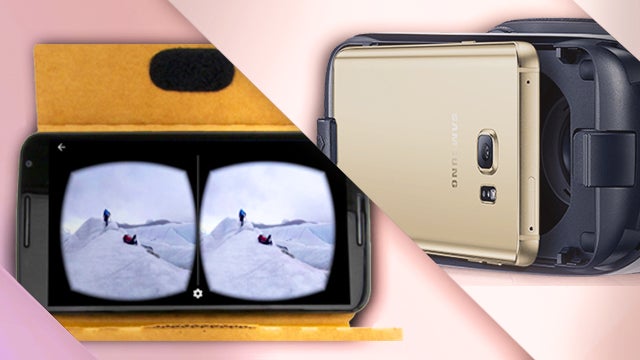
Not all of us are willing or able to splash out on hardcore VR systems like the Oculus Rift or HTC Vive. For the curious dabbler, there are numerous cheap and cheerful smartphone-based solutions.
Whether you’re constructing your own VR viewer out of cardboard with Google’s help, catching a glimpse of Oculus magic, or rocking something more eccentric like Brian May’s OWL stereoscope, there are plenty of ways to turn your phone into a VR headset.
Here’s a rundown of some of the best and most interesting options.
Choosing a good VR phone
Chances are you already have a decent smartphone and you want to use it to dabble in VR. But if you’re in process of shopping for a new phone and VR performance is high up on your list of priorities, it’s worth keeping a few things in mind.
The first thing we’ll say is to go with an Android phone. Apple’s iPhone range is great, and they can be utilised with Google Cardboard headsets (for example), but Android really is where it’s at with VR right now.
Why? Because VR is arguably the one area where having a QHD – or even a 4K – display is important. Most budget VR solutions place your phone mere inches from your eyes, so you’ll really be able to spot those pixels, and Android phones are the only ones where large, QHD displays are a common feature.
The second thing we’ll say is to go for a high-performance smartphone. Alongside a crisp, responsive screen, smoothness is key to a decent VR experience, so a quality mobile processor and GPU is a must.
Related: What is VR?

As such, your ideal VR smartphone will be a recent flagship Android phone. Samsung’s latest efforts, the Samsung Galaxy S8 and Samsung Galaxy S8 Plus tick all the boxes because they’re big, fast, and have the best screens in the business. They also grant access to the fine Samsung Gear VR as well as Google Cardboard, so they will give you more options than other phones.
Otherwise, you’ll be well served by any of the current high-end Android crop, such as the LG G6.
Most of the 2015 crop would be up to the task too. Of particular note here is the Sony Xperia Z5 Premium, which ships with a whopping 4K display. This is pretty pointless in virtually every respect – except when it comes to VR, where its OTT sharpness is a considerable plus. It’s a shame then that you can’t actually make use of the 4K display for VR purposes, yet.
Choosing the right VR kit
Whether you’re buying a new phone or working with your existing set-up, you’ll probably be able to enjoy a decent mobile VR experience.
The most important stage is to select the best VR kit for your situation. Here’s a run down of some of the leading options, and whether they’re worthwhile.
Related: Best Google Cardboard apps
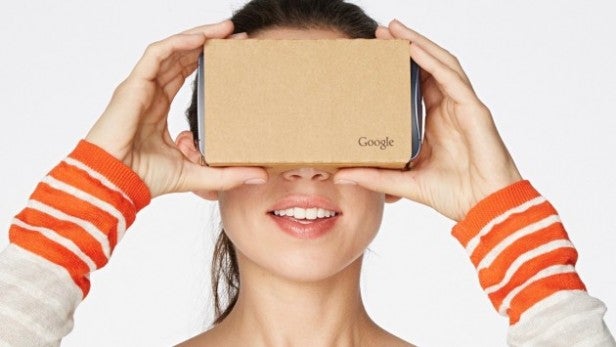
Google Cardboard
Google Cardboard is the most accessible mobile VR solution on the market, and as such will be the best starting point for most people.
For one, it’s incredibly cheap. Google will sell you a basic Cardboard headset for just £15 through the Google Store. You just assemble the headset according to some simple folding instructions, insert your phone, and you’re away.
Aside from this, there are plenty of third-party viewer options available from Amazon and the like. Some offer you more premium materials and comfortable straps for a little more money, while others give you a basic, Cardboard-like experience but for even less – this headset is under £4, for example. All Amazon listings should feature a list of compatible handsets, so check before you buy.
The other main benefit of Google Cardboard is that it’ll work with nearly any device. It supports both Android and iOS and there are VR apps for both platforms, so you’ll enjoy access to a healthy range of immersive 360-degree content.
In addition, you’ll find that Google Cardboard headsets come with a QR code for calibrating your phone, so set-up should be a doddle despite the crazy number of variables.
Even if you’re not sure if VR is for you, Google Cardboard is the perfect way to dip your toe in the waters.
Buy Now: Google Cardboard at Amazon from £4
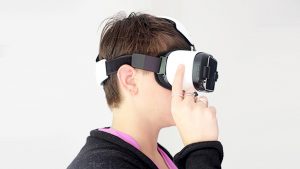
Samsung Gear VR
If you do have a fairly recent Samsung phone (from the Samsung Galaxy S6 or S7 families, or the Note 5), you should seriously consider investing in the Samsung Gear VR, which is a major step up from Google Cardboard in terms of sophistication and quality.
That’s largely thanks to the fact that it was built in conjunction with Facebook-owned Oculus, the make of the full-blown Oculus Rift VR headset that’s been wowing everyone. The Gear VR has access to some of that Oculus content, as well as some of Samsung’s own efforts, and the Oculus app will be automatically installed when you slot your phone into the headset for the first time.
It’s a very well built piece of kit that sits comfortably on your head, with simple controls directly on the side of the headset. The Gear VR won’t cost the earth, either. At the time of writing, it’s available for £80 or less at a number of online retailers.
BUY NOW: Samsung Gear VR headset at Amazon from £48
Of course, the limited handset support is a bit of a shame, but they’re hardly uncommon or undesirable phones, and it does mean you get a more consistent VR experience.
Related: Samsung Gear VR vs LG 360 VR
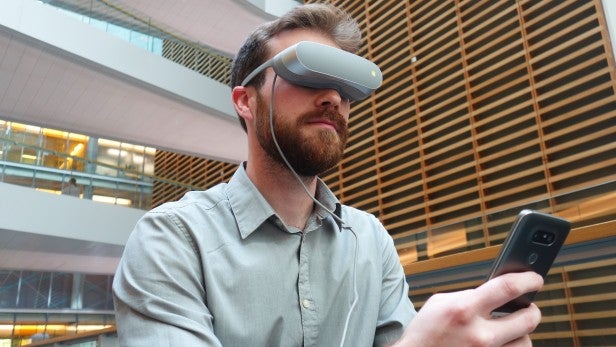
LG 360 VR
LG’s 360 VR headset is now on the market, and it must be a serious rival to Samsung’s quality Gear VR, right? If only.
We found the LG 360 VR to be a terrible device in almost every way, with a fiddly headset that doesn’t block out the real world, glitchy software, poor performance, and a bafflingly high price point.
We’ll give it points for offering a VR experience that’s approaching portable – it’s like a chunky set of fold-away glasses that has its own display and plugs into a phone for power and controls. But that’s about it for the good stuff.
It also only works with one model of phone, the LG G5. Which is decent, but not as good as Samsung’s or HTC’s latest.
Even if you’ve already invested in an LG G5, don’t buy the LG 360 VR headset. You’re better off with a Google Cardboard headset, which will make similar use of that big sharp display.
Notable mentions
There are a couple of potential mobile VR alternatives that have emerged from China of late, but availability issues and unknown ecosystems mean you might be best off holding fire.
Huawei is the world’s third-biggest smartphone manufacturer behind Samsung and Apple, so its Huawei VR is worth discussing. Announced in April, and set to launch some time in 2016, it looks and handles an awful lot like the Samsung Gear VR, which is no bad thing.
The key difference, of course, is that the Huawei VR works with the Huawei P9 (and Huawei P9 Plus) – an even smaller spread than Samsung’s offering. It’s also worth pointing out that these Huawei handsets don’t pack a QHD screen. The P9 family is ‘only’ 1080p, though you can expect future Huawei handsets to up the pixel count, and thus improve the Huawei VR experience.
Unfortunately, Huawei’s effort doesn’t benefit from Oculus support either, so it remains to be seen what kind of VR app ecosystem it can create off its own back.
Related: Everything you need to know about the OnePlus 3
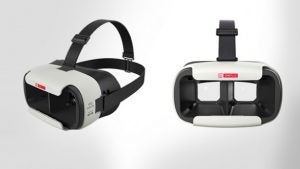
Plucky startup OnePlus also announced its own VR headset recently. The Loop VR is set to launch on June 6, and will be used to push the OnePlus 3, due out shortly thereafter.
We’re more than a little intrigued by OnePlus’s claim that the Loop VR will offer the “world’s first global shopping experience in VR”. Will it be a traditional VR experience, or just a virtual shopping mall? The latter option sounds less than ideal.
However, the Loop VR will be compatible with most 5 and 6-inch phones, so it’s got a compatibility advantage here.
Finally, a special mention must go to Brian May. Yes, THE Brian May, of legendary ’70s rockers Queen. He recently spoke to TrustedReviews about launching his own VR headset, the Owl VR.
Related: Why is Queen’s Brian May unveiling a ‘Victorian VR’ rival to Google Cardboard?

The ace guitarist (and qualified astrophysicist) is a keen 3D and VR fan, and has developed the new equipment to allow anyone to turn their smartphone into a virtual reality viewer.
It’s essentially a simple Google Cardboard-like smartphone holder – in fact, it’s even simpler – and will be available mid-June for £25. It works with the Google Cardboard app, too.
The Owl VR’s appeal is in its accessibility, as unlike most other VR solutions it still allows you to access your phone’s controls whilst it’s fitted. And of course, like Google Cardboard, it will work with pretty much any phone. The downside is that it isn’t as immersive as other, enclosed standards – Cardboard is far superior in that sense, based on our testing.
Where to find VR content
Now that you’ve got your handset and VR headset sorted, you’ll be wanting some content. As we’ve already discussed, both Google Cardboard and the Samsung Gear VR will set you up with plenty of content from their respective stores, with the latter also having access to the Oculus Store.
But there are other sources of 360-degree and VR content. YouTube has build a strong library of 360-VR content that’s well worth checking out through its app, while Vrse and Fulldive VR are two fine dedicated VR content apps that should also be in your collection.
Want to take your VR experience even further? Check out the HTC Vive or Oculus Rift. Here’s a video of what the two devices offer:
Let us know about your mobile VR setup in the comments below.


